America to the Starving People of Russia


Detail, refugees on the riverbank in Ufa, circa 1922. Raymond McKnight Sloan papers, Hoover Institution Archives. Digital record.
Detail, refugees on the riverbank in Ufa, circa 1922. Raymond McKnight Sloan papers, Hoover Institution Archives. Digital record.
In the winter of 1922, Col. William Haskell, director of the American Relief Administration (ARA) in Soviet Russia, decided to launch a propaganda offensive. The goal was to counter rumors circulating among Soviet citizens regarding the purportedly malicious motives behind American relief to the famine stricken. Haskell arranged for the mass production and distribution of posters, designed by Moscow artists, as a way to spread the word that ARA food and medicine was an altruistic gift from the American people to all those suffering and in need.
Herbert Hoover's response to Maxim Gorky's July 1921 appeal for aid to combat the Soviet famine led to tense negotiations between Soviet and American Relief Administration (ARA) officials in Riga, Latvia. From the moment Hoover responded, Kremlin leaders were leery of his real motives and feared that the ARA could serve as a kind of imperialist Trojan horse: as the Riga negotiations got under way in August, an article published in the Petrograd Party newspaper Krasnaia gazeta (The Red Gazette) warned by its title of “The Greek Hoover and His Gifts.”1 The author expressed outrage at the conditions Hoover had laid down in his telegram to Gorky, the essential one being American control over the distribution of ARA food.
During the Riga negotiations, Vladimir Lenin was quite skittish. On August 11, the second day of the negotiations, he had a message sent to the Soviet negotiator, Deputy People's Commissar of Foreign Affairs Maxim Litvinov, cautioning him to be especially on his guard. On the same day he wrote an agitated note to the Politburo, warning that there was a “highly complex game going on” involving the trickery of America, Hoover, and the League of Nations, by which he meant the Allied Supreme Council in Paris. It was absolutely essential, Lenin wrote, to name a special Politburo commission to deal with the day-to-day questions of foreign relief.
“Hoover must be punished, must be publicly slapped so that the whole world can see.” Lenin urged vigilance, calling Hoover an “insolent liar.” “Delicate maneuvers are needed,” he told the Politburo.
As for Hoover's relief workers, “We must establish superstrict conditions: for the slightest interference in internal matters—expulsion and arrest.”2 It did not help matters that on the eve of the mission a series of articles appeared in the journal World's Work written by the former ARA chief in Hungary who boasted that Hoover and the ARA had been responsible for the downfall of Béla Kun's short-lived Communist regime in Budapest in April 1919.

Maxim Gorky, circa 1920; and Herbert Hoover photographed by Underwood and Underwood, New York, 1917. Digital record.
Maxim Gorky, circa 1920; and Herbert Hoover photographed by Underwood and Underwood, New York, 1917. Digital record.
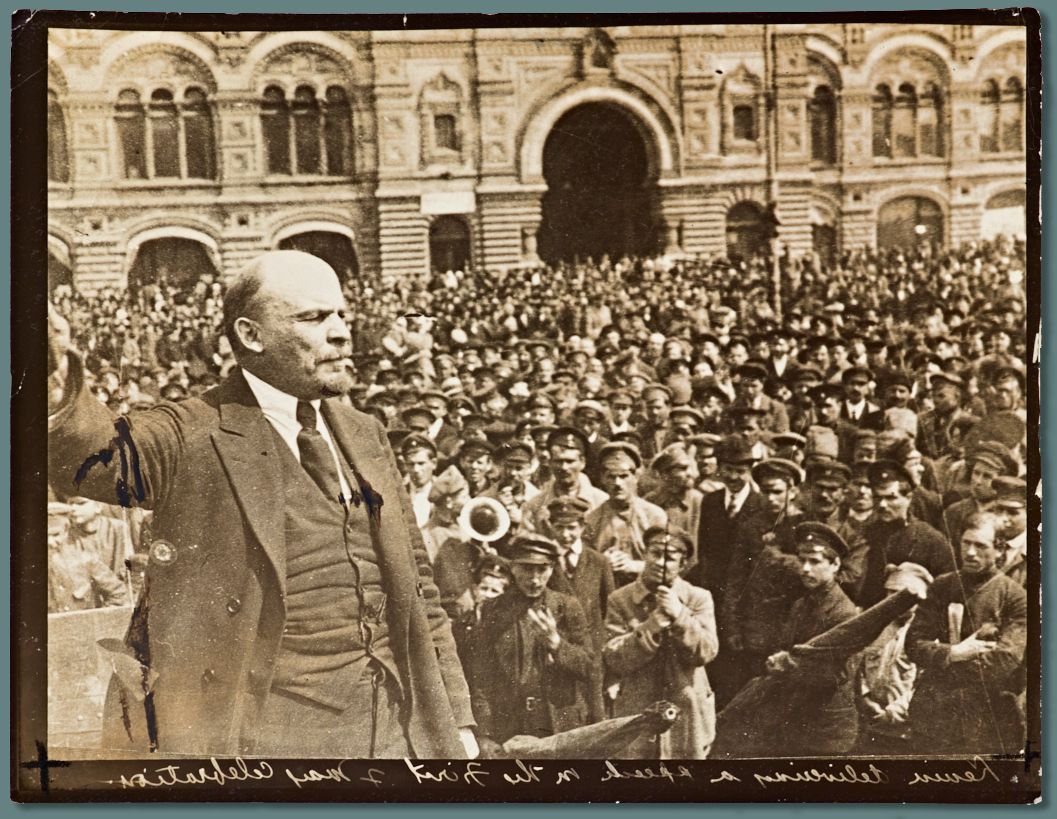
Lenin speaking before a crowd, Red Square, Moscow, circa 1919. Hugh Anderson Moran papers (48025), Hoover Institution Archives.
Lenin speaking before a crowd, Red Square, Moscow, circa 1919. Hugh Anderson Moran papers (48025), Hoover Institution Archives.
Herbert Hoover's response to Maxim Gorky's July 1921 appeal for aid to combat the Soviet famine led to tense negotiations between Soviet and American Relief Administration (ARA) officials in Riga, Latvia. From the moment Hoover responded, Kremlin leaders were leery of his real motives and feared that the ARA could serve as a kind of imperialist Trojan horse: as the Riga negotiations got under way in August, an article published in the Petrograd Party newspaper Krasnaia gazeta (The Red Gazette) warned by its title of “The Greek Hoover and His Gifts.”1 The author expressed outrage at the conditions Hoover had laid down in his telegram to Gorky, the essential one being American control over the distribution of ARA food.

Maxim Gorky, circa 1920; and Herbert Hoover photographed by Underwood and Underwood, New York, 1917. Digital record.
During the Riga negotiations, Vladimir Lenin was quite skittish. On August 11, the second day of the negotiations, he had a message sent to the Soviet negotiator, Deputy People's Commissar of Foreign Affairs Maxim Litvinov, cautioning him to be especially on his guard. On the same day he wrote an agitated note to the Politburo, warning that there was a “highly complex game going on” involving the trickery of America, Hoover, and the League of Nations, by which he meant the Allied Supreme Council in Paris. It was absolutely essential, Lenin wrote, to name a special Politburo commission to deal with the day-to-day questions of foreign relief.
“Hoover must be punished, must be publicly slapped so that the whole world can see.” Lenin urged vigilance, calling Hoover an “insolent liar.” “Delicate maneuvers are needed,” he told the Politburo.

Lenin speaking before a crowd, Red Square, Moscow, circa 1919. Hugh Anderson Moran papers (48025), Hoover Institution Archives.
As for Hoover's relief workers, “We must establish superstrict conditions: for the slightest interference in internal matters—expulsion and arrest.”2 It did not help matters that on the eve of the mission a series of articles appeared in the journal World's Work written by the former ARA chief in Hungary who boasted that Hoover and the ARA had been responsible for the downfall of Béla Kun's short-lived Communist regime in Budapest in April 1919.

Maxim Gorky, circa 1920; and Herbert Hoover photographed by Underwood and Underwood, New York, 1917. Digital record.
Maxim Gorky, circa 1920; and Herbert Hoover photographed by Underwood and Underwood, New York, 1917. Digital record.

Detail from an American Relief Committee for Hungarian Sufferers poster, circa 1918. Poster Collection US 3236, Hoover Institution Archives. Digital record.
Detail from an American Relief Committee for Hungarian Sufferers poster, circa 1918. Poster Collection US 3236, Hoover Institution Archives. Digital record.
ARA relief was premised on American control of the food it distributed—a guarantee that Hoover made to the American people, who gave support through their donations of money. This control took the form of committees of local citizens, selected and supervised by Americans, to carry out the distribution of food. During the Riga negotiations, Lenin was sufficiently nervous about what might come of the ARA's independent activity that he instructed Litvinov to propose to the Americans that the Soviet government give the ARA a security deposit—made in New York, in gold—in the amount of 120 percent of the value of one month's supply of foodstuffs, in return for which the ARA would leave the distribution of its food entirely in Soviet hands. Of course this was not something Hoover could agree to.3
In fact, Lenin had reasonable grounds to be paranoid about Hoover. Besides being celebrated as the Great Humanitarian for leading food relief efforts during and after World War I, Hoover was also known at that time as America's leading anti-Bolshevik, and in 1918 he made no secret of his desire to feed people in order to “stem the tide of Bolshevism” in Europe. Indeed, by 1920 American food was widely seen on both sides of the Atlantic as having prevented Europe from slipping into Bolshevism. And Hoover was never shy about taking the credit for the United States. Several years later, he wrote in a private letter that “at no time were we of any other mind than that the European relief in 1919 was the greatest battle ever made against Bolshevism.”4
So, the Bolsheviks in the Kremlin had good reason to be on their guard when the Riga Agreement was signed on August 20, 1921. Three days later, Lenin wrote to the Politburo urging that in anticipation of “a lot of Americans” coming into Soviet Russia, a commission be formed to organize the surveillance of these foreigners through the Cheka. “The main thing is to identify and mobilize the maximum number of Communists who know English, to introduce them into the Hoover commission and for other forms of surveillance and intelligence.” Two weeks later, reacting to a report of suspect behavior on the part of individual relief workers, Lenin wrote to People's Commissar of Foreign Affairs Georgy Chicherin that “as for the hooverites, we must shadow them with all our might.” The most unsavory among them had to be compromised by creating scandals around them. “This calls for a brutal, sustained war.”5
Yet Lenin and his fellow Bolsheviks' worst fears about the ARA quickly dissipated. They soon realized that Hoover's relief workers, whose feeding operations developed at remarkable speed, were honoring their promise to deliver food without regard to class, politics, or religion. These hyper efficient Americans kept strictly to business and did not try—as Litvinov had phrased it during the Riga negotiations—to use “food as a weapon” by feeding anti-Soviet elements.

Why Peace Must Hasten. Cartoon by Rollin Kirby in New York World. From The Literary Digest, March 22, 1919. Internet Archive digital record.
Why Peace Must Hasten. Cartoon by Rollin Kirby in New York World. From The Literary Digest, March 22, 1919. Internet Archive digital record.

Herbert Hoover overseeing the shipping of relief supplies to postwar Europe from New York, 1920. Herbert Hoover Presidential Library
Herbert Hoover overseeing the shipping of relief supplies to postwar Europe from New York, 1920. Herbert Hoover Presidential Library

Georgy Vasilyevich Chicherin, people's commissar of foreign affairs, at left, and his deputy Maxim Litvinov, 1920. National Library of Norway digital record.
Georgy Vasilyevich Chicherin, people's commissar of foreign affairs, at left, and his deputy Maxim Litvinov, 1920. National Library of Norway digital record.
ARA relief was premised on American control of the food it distributed—a guarantee that Hoover made to the American people, who gave support through their donations of money. This control took the form of committees of local citizens, selected and supervised by Americans, to carry out the distribution of food. During the Riga negotiations, Lenin was sufficiently nervous about what might come of the ARA's independent activity that he instructed Litvinov to propose to the Americans that the Soviet government give the ARA a security deposit—made in New York, in gold—in the amount of 120 percent of the value of one month's supply of foodstuffs, in return for which the ARA would leave the distribution of its food entirely in Soviet hands. Of course this was not something Hoover could agree to.3
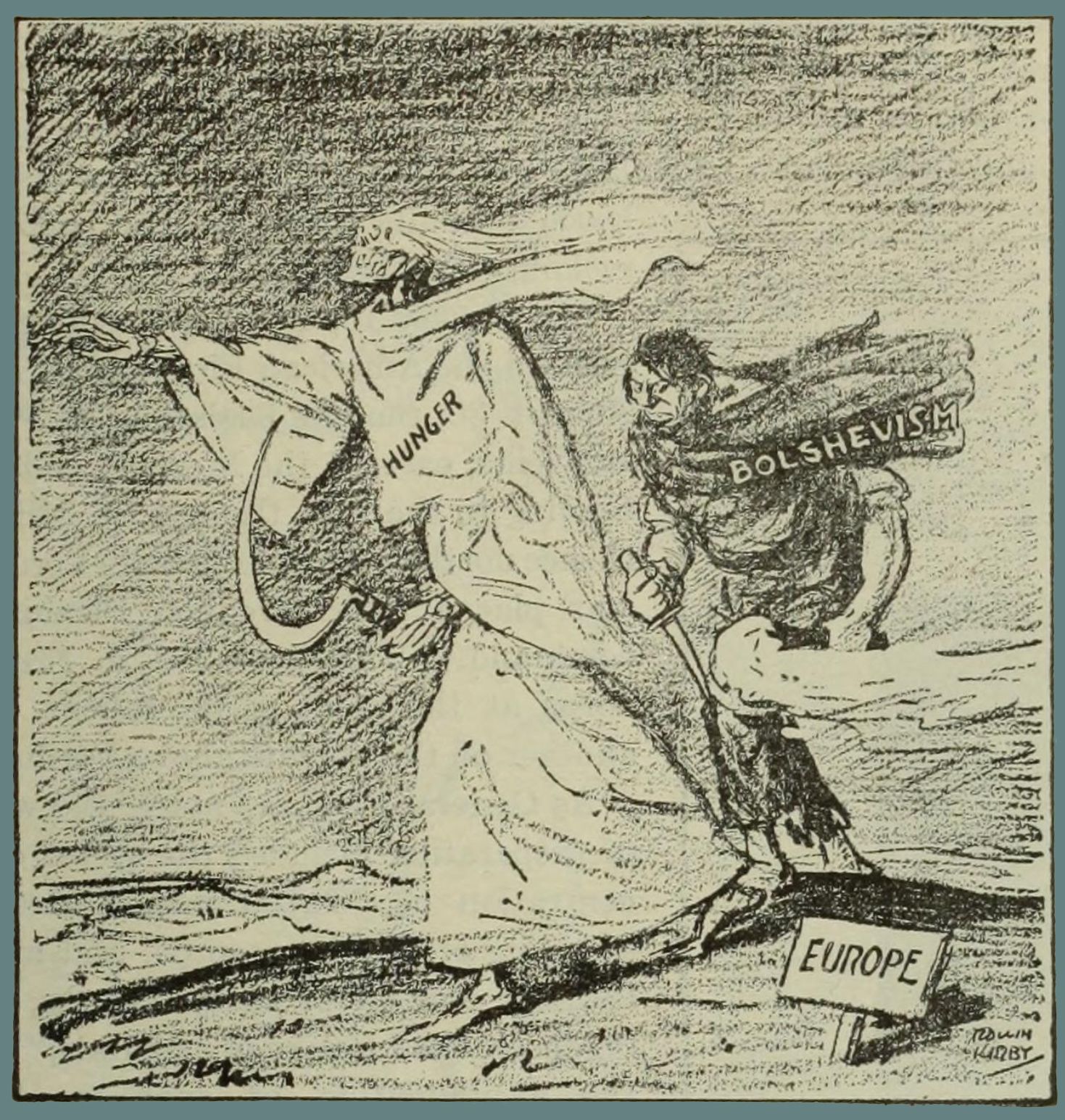
Why Peace Must Hasten. Cartoon by Rollin Kirby in New York World. From The Literary Digest, March 22, 1919. Internet Archive digital record.
In fact, Lenin had reasonable grounds to be paranoid about Hoover. Besides being celebrated as the Great Humanitarian for leading food relief efforts during and after World War I, Hoover was also known at that time as America's leading anti-Bolshevik, and in 1918 he made no secret of his desire to feed people in order to “stem the tide of Bolshevism” in Europe. Indeed, by 1920 American food was widely seen on both sides of the Atlantic as having prevented Europe from slipping into Bolshevism. And Hoover was never shy about taking the credit for the United States. Several years later, he wrote in a private letter that “at no time were we of any other mind than that the European relief in 1919 was the greatest battle ever made against Bolshevism.”4

Herbert Hoover overseeing the shipping of relief supplies to postwar Europe from New York, 1920. Herbert Hoover Presidential Library
So, the Bolsheviks in the Kremlin had good reason to be on their guard when the Riga Agreement was signed on August 20, 1921. Three days later, Lenin wrote to the Politburo urging that in anticipation of “a lot of Americans” coming into Soviet Russia, a commission be formed to organize the surveillance of these foreigners through the Cheka. “The main thing is to identify and mobilize the maximum number of Communists who know English, to introduce them into the Hoover commission and for other forms of surveillance and intelligence.” Two weeks later, reacting to a report of suspect behavior on the part of individual relief workers, Lenin wrote to People's Commissar of Foreign Affairs Georgy Chicherin that “as for the hooverites, we must shadow them with all our might.” The most unsavory among them had to be compromised by creating scandals around them. “This calls for a brutal, sustained war.”5
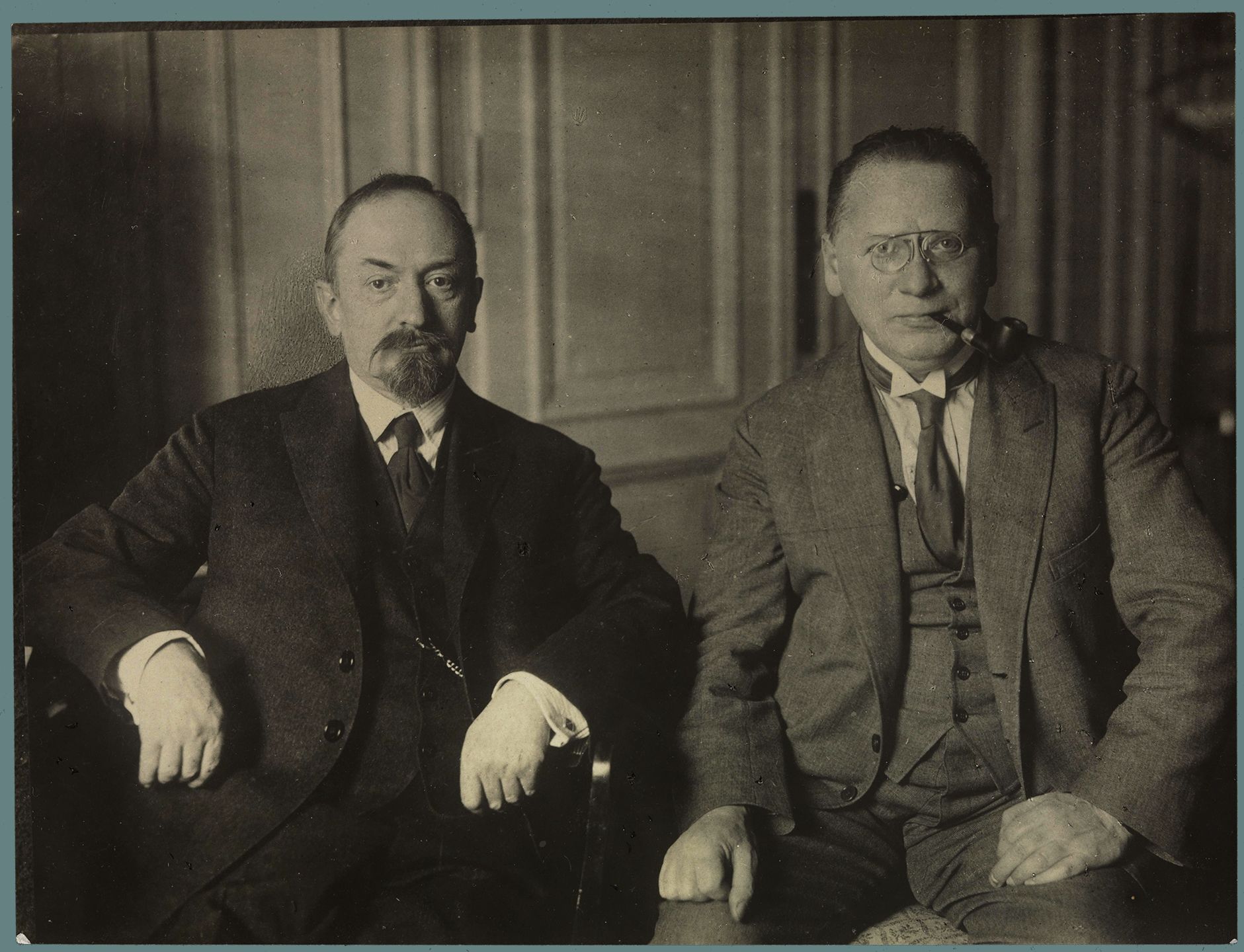
Georgy Vasilyevich Chicherin, people's commissar of foreign affairs, at left, and his deputy Maxim Litvinov, 1920. National Library of Norway digital record.
Yet Lenin and his fellow Bolsheviks' worst fears about the ARA quickly dissipated. They soon realized that Hoover's relief workers, whose feeding operations developed at remarkable speed, were honoring their promise to deliver food without regard to class, politics, or religion. These hyper efficient Americans kept strictly to business and did not try—as Litvinov had phrased it during the Riga negotiations—to use “food as a weapon” by feeding anti-Soviet elements.

Why Peace Must Hasten. Cartoon by Rollin Kirby in New York World. From The Literary Digest, March 22, 1919. Internet Archive digital record.
Why Peace Must Hasten. Cartoon by Rollin Kirby in New York World. From The Literary Digest, March 22, 1919. Internet Archive digital record.

Herbert Hoover overseeing the shipping of relief supplies to postwar Europe from New York, 1920. Herbert Hoover Presidential Library
Herbert Hoover overseeing the shipping of relief supplies to postwar Europe from New York, 1920. Herbert Hoover Presidential Library

Georgy Vasilyevich Chicherin, people's commissar of foreign affairs, at left, and his deputy Maxim Litvinov, 1920. National Library of Norway digital record.
Georgy Vasilyevich Chicherin, people's commissar of foreign affairs, at left, and his deputy Maxim Litvinov, 1920. National Library of Norway digital record.
Once their worst suspicions were eased, Lenin and his colleagues were free to consider Hoover and the ARA as an opportunity. Lenin had in March 1921 begun the introduction of the mixed-market New Economic Policy (NEP), a retreat from the draconian policies of War Communism, which had involved the nationalization of industry, a prohibition on trade, and the requisitioning of grain and other agricultural products. This change of course was greeted with consternation in the party's ranks, even though Lenin referred to it as merely a strategic retreat. Staging a communist revolution in backward Russia in 1917 had been justified by the idea that this would serve as the detonator for revolution in the rest of Europe. But despite the political instability in postwar Europe, communism did not spread westward. It remained isolated in Russia.
Lenin was eager to have Soviet Russia break out of its isolation by establishing diplomatic and trade relations with Western countries, as it had begun to do with the introduction of NEP. Now Lenin's hope was to convert the connection to the ARA into economic and trade ties with and investment from the United States, the only country with genuine economic clout after the war—and the only diplomatic hold-out among the major Western powers.
In October 1921, once the Americans had fanned out across the famine zone and were opening their feeding stations—which eventually numbered nearly 18,000—Lenin struck a very different tone in a note to Chicherin: “Hoover is a real plus.” And again, several days later: “Agreements and concessions with the Americans are super important to us: with Hoover we have something worthwhile.”6 Lenin argued that the Bolsheviks, in seeking to master trade, could benefit by watching the Americans in action.

Still, Lenin and his colleagues remained wary: the very presence of an American relief organization operating inside Soviet Russia constituted a dangerous threat, even if it engaged in purely humanitarian relief and steered clear of politics. This is what Litvinov had in mind earlier when, in the midst of the Riga negotiations, he sent a “top secret” telegram to Chicherin:
“Received impression that ARA comes to us without ulterior motives, but will cause us much trouble.”7
Aside from the government's embarrassment at having to be bailed out by Hoover's relief organization, it was feared that the example of American energy and efficiency might give some Soviet citizens the wrong idea about the wisdom of the communist experiment. And so, the Bolshevik authorities made every effort to gain control of relief operations—or at least to give the appearance of control. At the same time, they went to great lengths to minimize the importance of the relief and even its true source, calling it a gift from the American “proletariat.”
The American relief workers based in Saratov reported that government officials carried on a “steady and pernicious propaganda” campaign to the effect that the ARA had been sent by the American working class.8 In fact this line was not always entirely insincere. Prominent “Bolos,” as the Americans referred to the Bolsheviks, knew better, but those of a lower order, who had never been abroad and had been introduced to Marxism by the Leninists in power, would have been inclined to accept the propaganda of the Communist Party's high priests about the fierceness of the class struggle in that distant land. Moreover, it is not hard to imagine how ordinary Soviet citizens, and not only those sympathetic to the Bolsheviks, might presume a role for the American proletariat. It made it easier to grasp why the Americans had come to the rescue of the Soviet government, something many considered to be an important consequence of famine relief to Russia. Who else in America but the laboring classes would want to bail out the Bolsheviks?
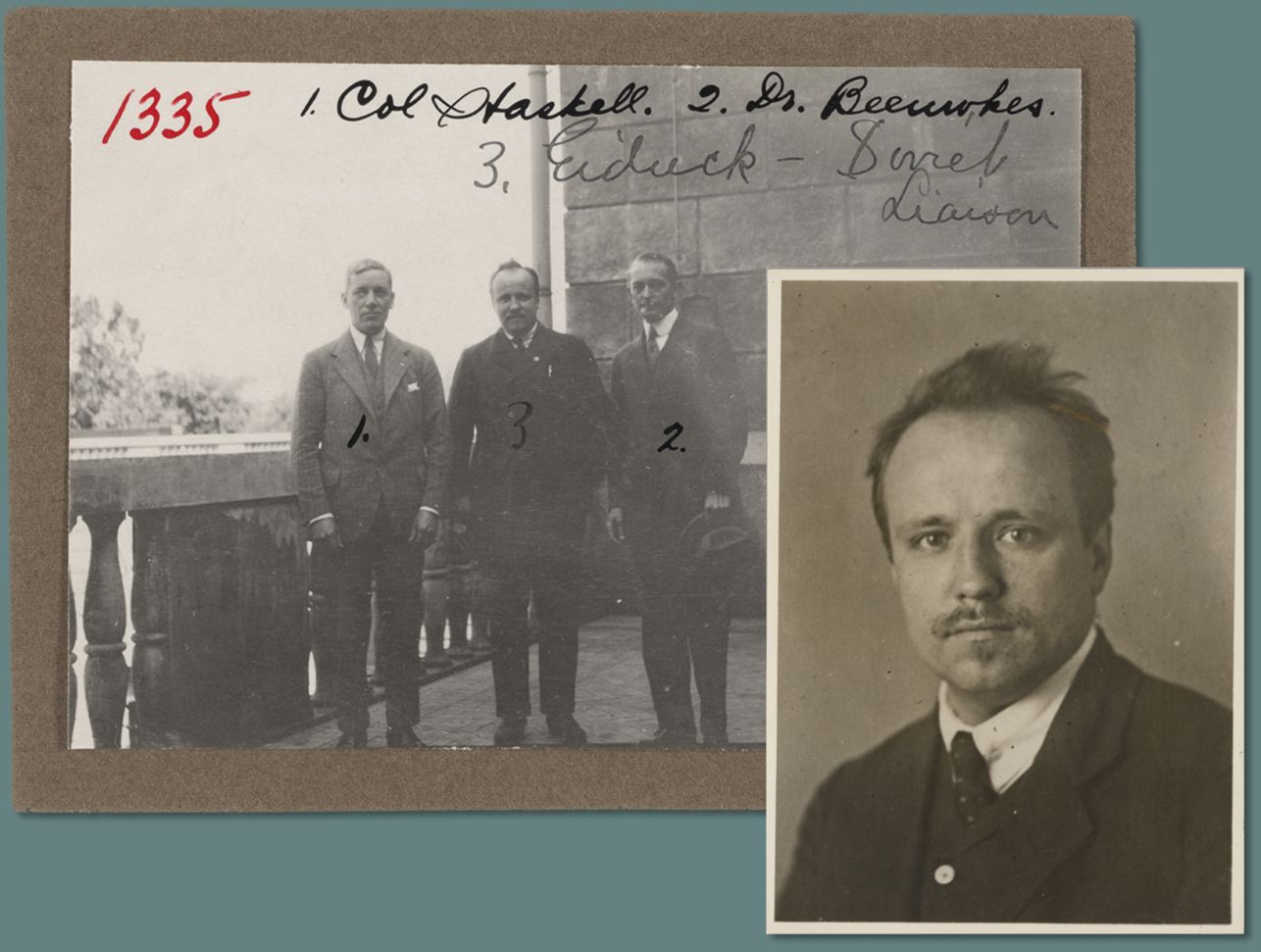
Aleksandr Vladimirovich Eiduk, plenipotentiary representative of the Russian Socialist Federative Soviet Republic with the ARA. Portrait overlays a photo of him between William Haskell, ARA director, and Henry Beeuwkes, ARA medical division director, circa 1922. Digital record 1. Digital record 2.
Aleksandr Vladimirovich Eiduk, plenipotentiary representative of the Russian Socialist Federative Soviet Republic with the ARA. Portrait overlays a photo of him between William Haskell, ARA director, and Henry Beeuwkes, ARA medical division director, circa 1922. Digital record 1. Digital record 2.

Richard Rein, chairman of the Simbirsk District Gubispolkom (provincial soviet), Edward Fox, ARA district supervisor, and Stephan Tchernik, Soviet central government representative to ARA, Simbirsk, April 4, 1922. Digital record. Variant record 1. Variant record 2.
Richard Rein, chairman of the Simbirsk District Gubispolkom (provincial soviet), Edward Fox, ARA district supervisor, and Stephan Tchernik, Soviet central government representative to ARA, Simbirsk, April 4, 1922. Digital record. Variant record 1. Variant record 2.

Detail, students receiving ARA food packages, Moscow, 1922. ARA Russia, box 400, folder 1.
Detail, students receiving ARA food packages, Moscow, 1922. ARA Russia, box 400, folder 1.
One assumption among Soviet officials was that the ARA was, one way or another, essentially a commercial venture, that the relief workers' most important role was scouting out future opportunities for American business. In an interview with the party's official newspaper, Pravda [Truth], Soviet leader Leon Trotsky called the Hoover mission a “highly skillful feeler projected by the ruling elements of America into the very depths of Russia.”9 Thomas Barringer, who served with the ARA, first in Ekaterinoslav (today called Dnipro, in Ukraine) and then as district supervisor in Simbirsk on the Volga, testified to the sincerity of this idea among the Communists he encountered: “It's hard for a Bolo official to realize that our relief work was in the interest of suffering humanity and not a clever Yankee scheme for coming into a ripe Russian field some day on a ‘grand scale.’ Having nothing except control they talk in the language of a dictator instead of that of a bankrupt.”10
It was also claimed that the American famine relief operation was itself already a form of commerce, that the relief supplies were not philanthropy but had to be paid for. Various aspects of the ARA's “businesslike” methods of operation reinforced this idea among the public, while Soviet officials were inclined to assume it. In Simbirsk the ARA's James Somerville saw the middle- and lower-level Bolsheviks as true believers, for whom there could only be one reason that any capitalist country would mount a famine relief effort:
Taught as an A-B-C principle that all human conduct is guided purely by motives of self interest, how can the good Communistic Soviet government official be expected to think that such a thing as a relief organization animated by philanthropic motives is possible—the more so when that organization is from the most capitalistic of all states, and headed by a man who has been the kind of capitalist they most dislike and fear—through his having proved in practice that Capitalism is not incompatible with a square deal.11
The American relief workers realized that Soviet officials were not the source of every rumor going around about the ARA. Popular imagination did well enough on its own. In March 1922 the Soviet authorities were content to see the rumor spread that the ongoing government campaign to confiscate the Russian Orthodox Church treasures was necessary to pay for American relief. This idea was quietly encouraged by officials, but a charge of Bolshevik disinformation was usually impossible to prove.
It was much easier to make the case that the Soviet authorities had failed to take action to enlighten the public about the purpose of the ARA. For this there was a ready instrument at hand in the form of paragraph 21 of the Riga Agreement, which obligated the Soviet authorities to “acquaint the Russian people with the aims and methods of the relief work of the A.R.A. in order to facilitate the rapid development of its efficiency.” Efficiency aside, the idea was to make sure that the word got out that this lifesaving food was coming from America.
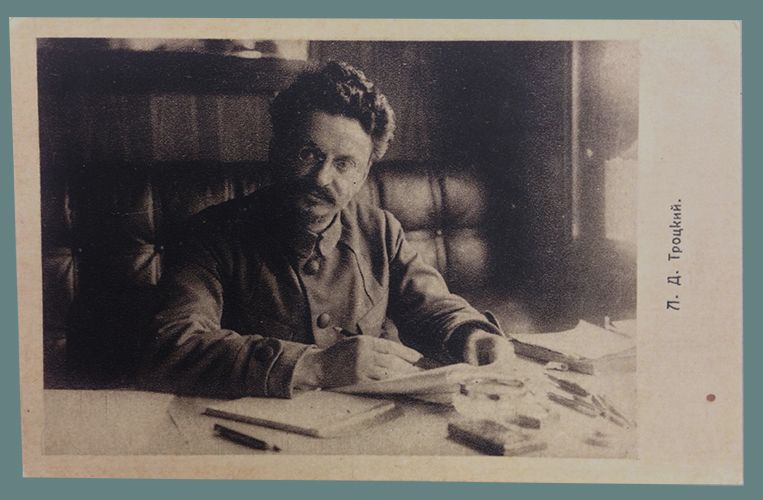
Leon Trotsky at work on train, circa 1920. Russian Pictorial collection, envelope AP, Hoover Institution Archives.
Leon Trotsky at work on train, circa 1920. Russian Pictorial collection, envelope AP, Hoover Institution Archives.

ARA Americans Thomas Barringer, Alvin Blomquist, Dr. Mark Godfrey, James Somerville, and William Otis in Simbirsk, circa 1922. ARA Russia, box 118.
ARA Americans Thomas Barringer, Alvin Blomquist, Dr. Mark Godfrey, James Somerville, and William Otis in Simbirsk, circa 1922. ARA Russia, box 118.
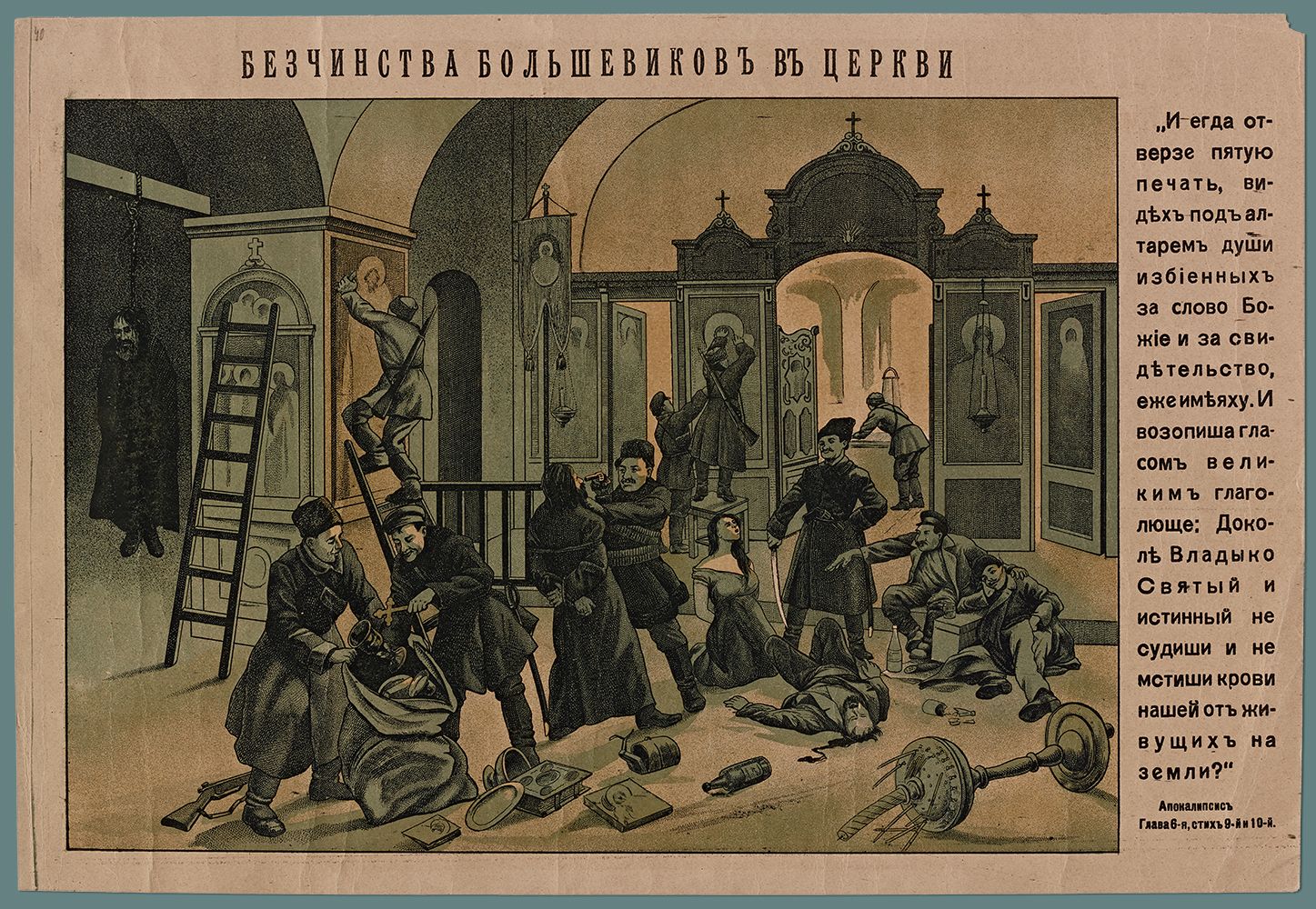
Безчинства большевиковъ въ церкви [Depredations of the Bolsheviks in the Church], 1918–20. Poster Collection RU/SU 9, Hoover Institution Archives. Digital record.
Безчинства большевиковъ въ церкви [Depredations of the Bolsheviks in the Church], 1918–20. Poster Collection RU/SU 9, Hoover Institution Archives. Digital record.
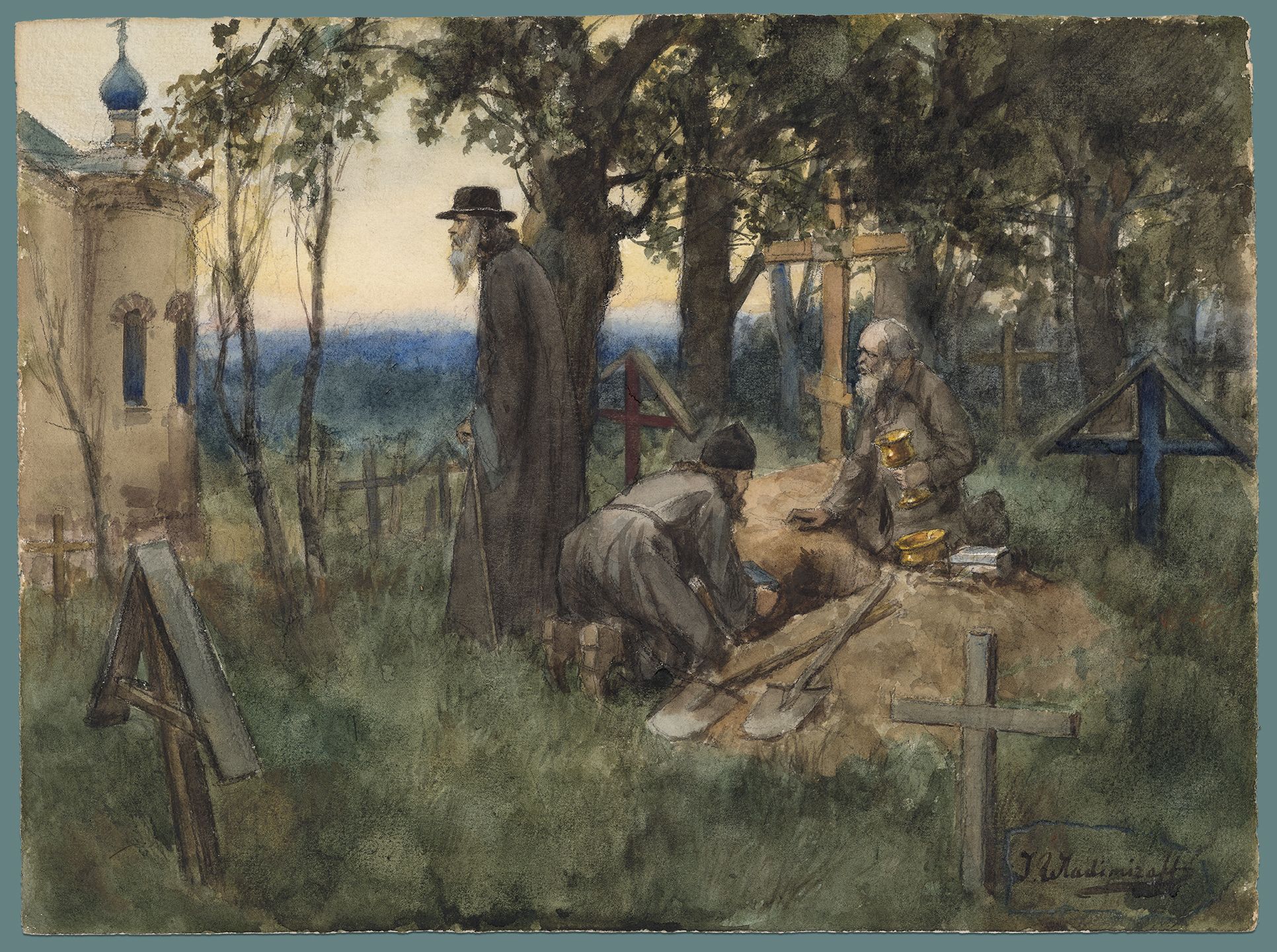
Russian clergy hiding church treasures in a fresh grave. Watercolor by Ivan Vladimirov (1869–1947), 1922. Ivan Alekseevich Vladimirov Paintings (24001.009), Hoover Institution Archives.
Russian clergy hiding church treasures in a fresh grave. Watercolor by Ivan Vladimirov (1869–1947), 1922. Ivan Alekseevich Vladimirov Paintings (24001.009), Hoover Institution Archives.

Detail of signature and ARA stamp from one of the ARA-Soviet agreements.
Detail of signature and ARA stamp from one of the ARA-Soviet agreements.
Naturally the Soviet authorities had little incentive to publicize the fact that their so-called class enemies had answered their call for help. Paul Clapp, stationed in the Volga district of Saratov, wrote in his diary, “It is a dose of Castor Oil for the Communists when they are called to openly admit they have made a bad mess of affairs.”12 Yet the ARA was too big to simply ignore outright. The central and local press did occasionally print articles accurately depicting the extent of the relief and expressing gratitude for it, although in the major newspapers the high-profile items were often framed in a way so as to promote the establishment of official US-Soviet relations.
In Moscow there was a deliberate attempt to create the impression that the Soviet authorities were playing a leading role in the ARA mission: the important thing was to maintain the image of undiminished authority at the center. Hoover's July 1921 telegraphed reply to Gorky's appeal for help was published in the Soviet newspapers in a way that made the Soviet government appear to be their recipient. Hoover's December 1921 telegram to Col. William Haskell, the ARA director in Russia, informing him of the passage of the Congressional appropriation of $20 million for Russian relief was published in the official Soviet government newspaper, Izvestiia [News], on December 30 under the rubric “Bor'ba s golodom” [“The struggle with famine”], framed as a message sent by Hoover to the Soviet liaison officer assigned to the ARA. Frank Golder, a curator for the Hoover Library serving with the ARA in Moscow, wrote:
“The impression they are trying to give is that the Soviet is running the ARA.”
After hearing Grigory Zinoviev, chairman of the Petrograd Soviet, cast aspersions on the motives of the ARA while speaking at a New Year's Eve celebration of the local soviet at the Petrograd Opera House, Golder wrote: “No matter what we do we are nothing more than capitalists who are trying to crush the life out of the proletariat.”13
The Odessa Americans found that while the local government was at first eager to have them fight the famine, in time “the officials felt that the A.R.A. was getting too popular, and that it was hurting them politically.”14 Even in the Ufa district, in the Ural Mountains, where the ARA had an exemplary record of government relations, Col. Walter Bell, the ARA district supervisor, complained of “the constant effort of the ones in control of affairs here to discredit and belittle the general operation.”15
In Orenburg, east of the Volga at the southeastern edge of European Russia, District Supervisor Walter Coleman constantly complained about local officials trying to take credit for all his initiatives. The worst villains were the government representatives sent from Moscow. “They all not only interfered but obstructed both actively and passively. Their instructions are to give the ARA credit for nothing and to divert the thunder to the Royal Holy Soviet Government.”16 Coleman decided to take matters into his own hands. Outside headquarters he posted a homemade bulletin board showing a breakdown of ARA feeding by subdistrict, which was regularly updated. He was pleased to report that “during the first few days after these were posted up they were almost as much stared at as the baseball bulletins in the United States.” As well, he had a stamp made up with the message “A.R.A. FREE” in Russian, and this was used on all kinds of ARA paperwork and packaging. In the Volga districts of Saratov, Simbirsk, and Tsaritsyn the ARA distributed signs reading “Gift of the American People” in Russian.17
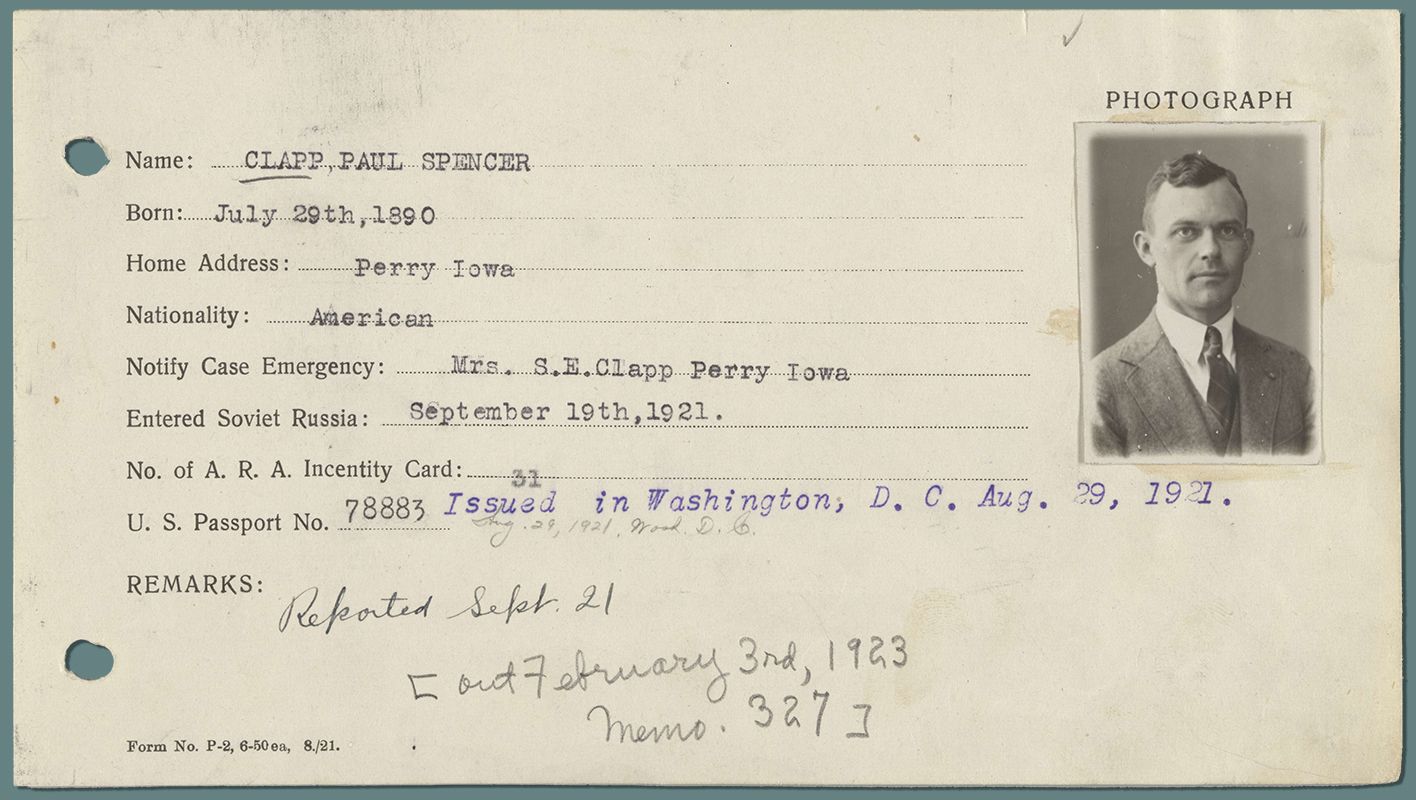
Paul Spencer Clapp, ARA identification paper, August 29, 1921. Digital record.
Paul Spencer Clapp, ARA identification paper, August 29, 1921. Digital record.

Col. William Haskel and Grigory Zinoviev, circa 1922. Digital record.
Col. William Haskel and Grigory Zinoviev, circa 1922. Digital record.

Frank A. Golder's ARA Russian ID, 1921. Frank A. Golder papers (XX058), box 1, folder 15, Hoover Institution Archives.
Frank A. Golder's ARA Russian ID, 1921. Frank A. Golder papers (XX058), box 1, folder 15, Hoover Institution Archives.

Col. Walter Bell, seated center, at his desk in Ufa, circa 1922. Digital record.
Col. Walter Bell, seated center, at his desk in Ufa, circa 1922. Digital record.
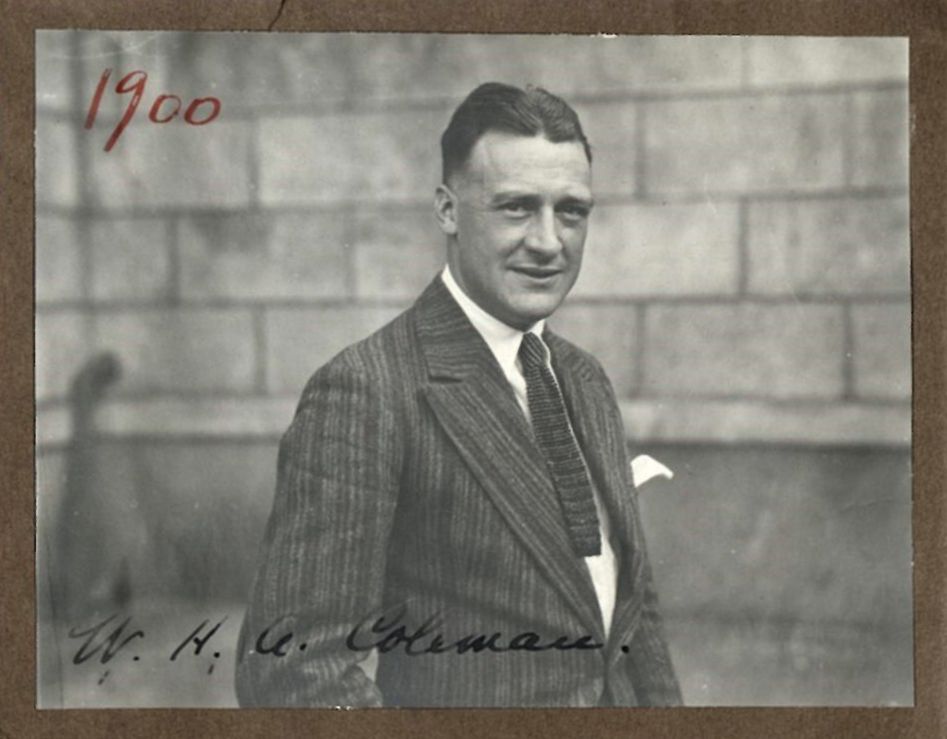
Walter Coleman, ARA district supervisor in Orenburg, circa 1922.
Walter Coleman, ARA district supervisor in Orenburg, circa 1922.

Detail of a report from the ARA Medical Department Simbirsk for the month of October 1922. ARA Russia, box 120, folder 4.
Detail of a report from the ARA Medical Department Simbirsk for the month of October 1922. ARA Russia, box 120, folder 4.
In Moscow Col. Haskell initiated a propaganda campaign of his own, which he recalled with obvious satisfaction several years later in an unpublished memoir. “Realizing that the great majority of Russians could neither read nor write, I decided to use a pictorial method of conveying the information. Among the artists of Moscow I instituted a competition for a poster which would best convey to even the illiterate the fact that Russia was being fed by American charity.”18 The winning entry depicts an enormous American cargo ship approaching a wharf on which is congregated a crowd of ragged, starving refugees—unmistakably Russian in appearance—some with hands outstretched in supplication toward the ship. The Russian text reads “Америка голодающим России” [America to the Starving People of Russia]. “It is interesting to note,” Haskell recalled, “that the Muscovite who won the prize with his ship had never seen either the ocean or a ship, and his idea of both of them had been obtained from a picture in a copy of the ‘Literary Digest’ which had come into his possession.”
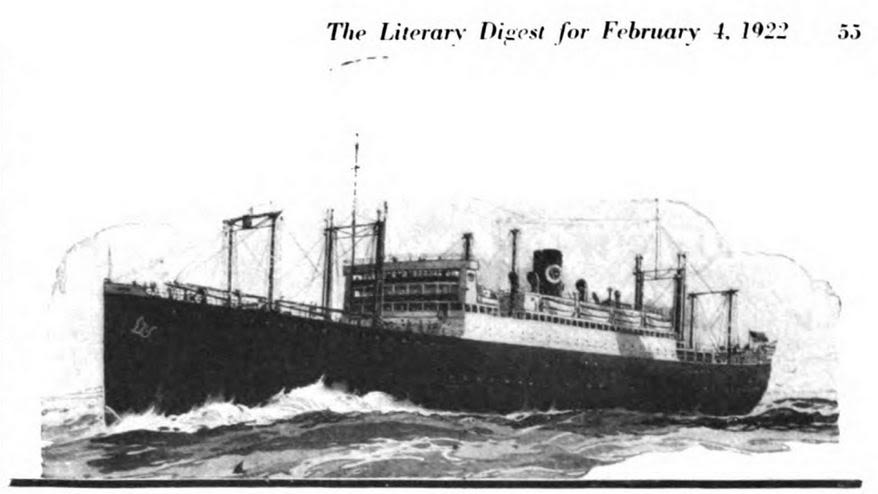
Possible inspiration for the winning poster design. The Literary Digest, vol. 72, no. 5 (February 4, 1922): 55. HathiTrust Digital Library. Digital record (#363).
Possible inspiration for the winning poster design. The Literary Digest, vol. 72, no. 5 (February 4, 1922): 55. HathiTrust Digital Library. Digital record (#363).
More striking is another ARA poster, perhaps the runner-up in the contest. It shows Lady Columbia, draped in the American flag, doling out porridge to four small Russian peasant children in a tiny village. The Russian text reads “Дар американского народа” [Gift of the American People]; some copies identify, in both Russian and English, Herbert Hoover as ARA Chairman. Its stark simplicity and maternal imagery made it a more effective messenger than its rival, proof of which is evident even today: examining archival photographs of ARA kitchens, where the display of one or both of these posters was made part of the regulations, the eye automatically locks on to the figure of Columbia.

Child patients in a hospital dining room provisioned by the ARA, c. 1922. Photograph edited to highlight poster. Digital record of original photo.
Child patients in a hospital dining room provisioned by the ARA, c. 1922. Photograph edited to highlight poster. Digital record of original photo.

William Haskell, Director of ARA Russian operations, circa 1922. Digital record.
William Haskell, Director of ARA Russian operations, circa 1922. Digital record.
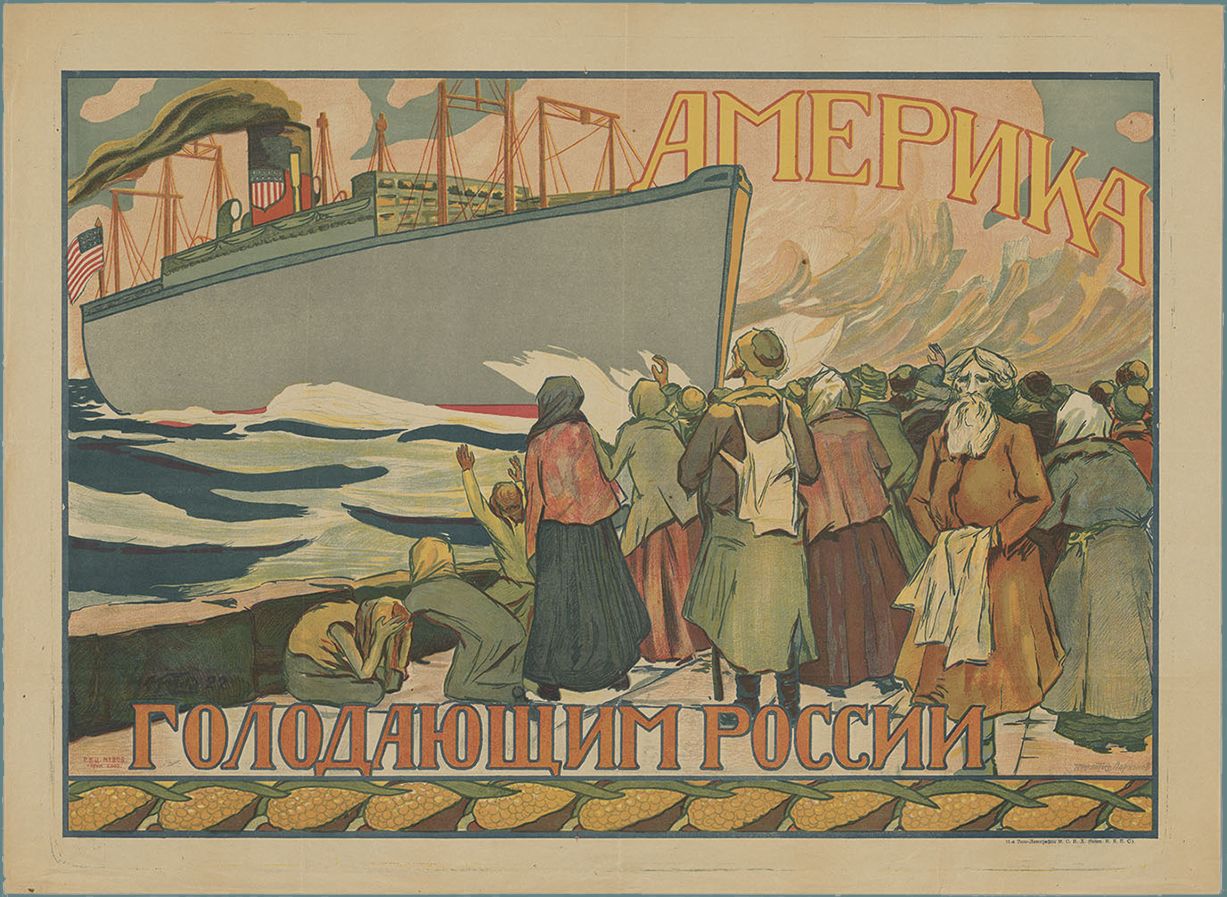
Америка голодающим России [America to the Starving People of Russia], 1922. Poster Collection RU/SU 1213, Hoover Institution Archives. Digital record.
Америка голодающим России [America to the Starving People of Russia], 1922. Poster Collection RU/SU 1213, Hoover Institution Archives. Digital record.
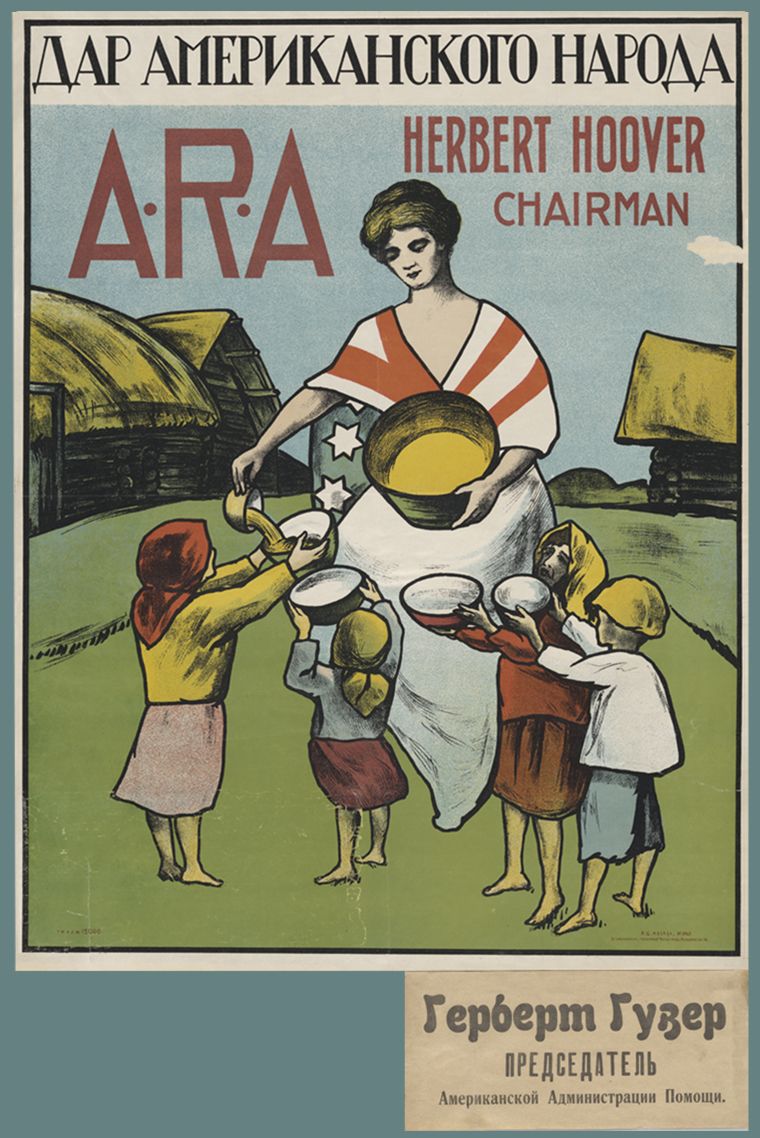








Американский подарок [American Gift], gouache and ink on paper, early 1922. Poster Collection RU/SU 1448. Digital record.
Американский подарок [American Gift], gouache and ink on paper, early 1922. Poster Collection RU/SU 1448. Digital record.

Дар американского народа, А.Р.А. [Gift of the American People, A.R.A.], 1922. Poster Collection RU/SU 502. Digital record.
Дар американского народа, А.Р.А. [Gift of the American People, A.R.A.], 1922. Poster Collection RU/SU 502. Digital record.

АРА Американский подарок [ARA American Gift], gouache and graphite on paper, early 1922. Digital record.
АРА Американский подарок [ARA American Gift], gouache and graphite on paper, early 1922. Digital record.

Американский подарок АРА [American Gift ARA], gouache and graphite on paper, early 1922. Digital record.
Американский подарок АРА [American Gift ARA], gouache and graphite on paper, early 1922. Digital record.

А. Р. А. Американская администрация помощи [A. R. A. American Relief Administration], 1922. Poster Collection RU/Su 1366. Digital record 1. Digital record 2.
А. Р. А. Американская администрация помощи [A. R. A. American Relief Administration], 1922. Poster Collection RU/Su 1366. Digital record 1. Digital record 2.

Американская Администрация Помощи, столовая но., дар американского народа [American Relief Administration, Kitchen No., Gift of the American People], 1922. Poster Collection RU/SU 1190. Digital record.
Американская Администрация Помощи, столовая но., дар американского народа [American Relief Administration, Kitchen No., Gift of the American People], 1922. Poster Collection RU/SU 1190. Digital record.

Photograph showing poster like the one at left (RU/SU 1190) in use at an ARA feeding station in Tsaritsyn, 1922. Digital record.
Photograph showing poster like the one at left (RU/SU 1190) in use at an ARA feeding station in Tsaritsyn, 1922. Digital record.
Copies of the two posters were lithographed in many thousands of copies and pasted onto both doors of every freight car leaving the ports. Aside from providing free publicity, doing so was also supposed to give these cars preference along the railway lines. When a train of these cars was thus outfitted, it must have attracted attention. It was not a spectacle many had the chance to witness; most of the posters were torn down very soon after leaving port. Haskell blamed the authorities for this, accusing them of having the offensive ornaments removed at the first railroad junction. When the ARA learned of this practice, he said, it distributed more posters to all junction points along the line. In Saratov, Clapp—of the castor oil analogy—said that the Bolsheviks found them “distasteful.” He reported that during the seventy-two continuous days he was lodged in a railway car they were torn down almost every night, so “irked” were officials at the sight of them.19 John Ellingston, based in Moscow, wrote of the ones posted in the capital that “very few of them enjoyed more than a day or two of glory.” Some were taken as souvenirs, some to be used as cigarette paper, and others just of out the “general spirit of destruction.”20
In the end, though, the surest ARA publicity was the American food itself. As William Kelley, a relief worker stationed in Ufa, said, “There was no disguising white flour, condensed milk and cocoa.”21
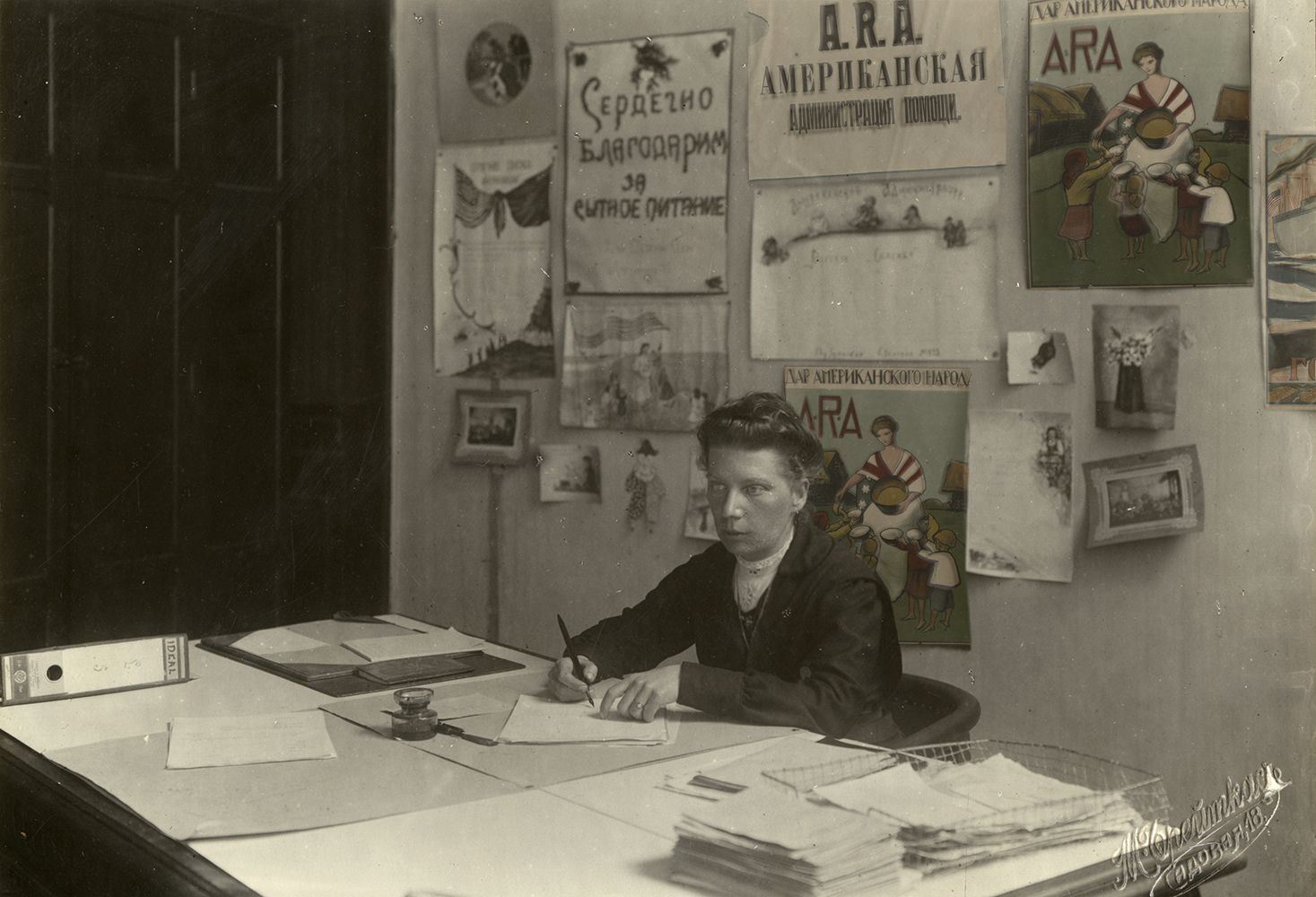

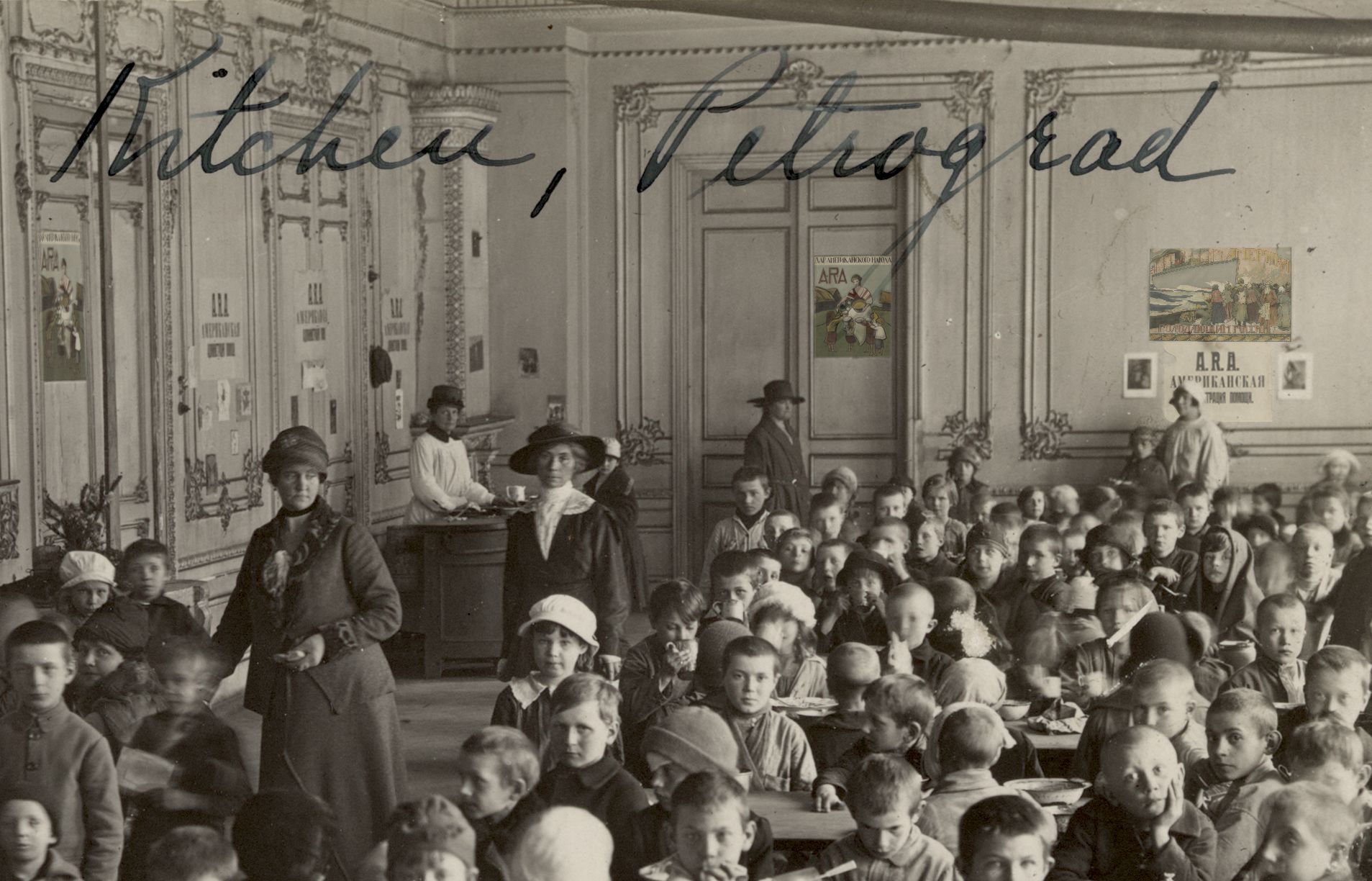


Lizzie Bach, manager of the ARA's kitchens in Petrograd, at her desk, circa 1922. Photographed by M. Breitkas. Photograph edited to highlight posters. Belgian-American Educational Foundation Records, Herbert Hoover Presidential Library and Museum.
Lizzie Bach, manager of the ARA's kitchens in Petrograd, at her desk, circa 1922. Photographed by M. Breitkas. Photograph edited to highlight posters. Belgian-American Educational Foundation Records, Herbert Hoover Presidential Library and Museum.

ARA kitchen managers, Petrograd, circa 1922. Photograph edited to highlight posters. ARA Russia, box 402, folder 4.
ARA kitchen managers, Petrograd, circa 1922. Photograph edited to highlight posters. ARA Russia, box 402, folder 4.

Detail of a photograph of an ARA Kitchen, Petrograd, 1922. Photograph cropped and posters highlighted. Digital record of original photograph.
Detail of a photograph of an ARA Kitchen, Petrograd, 1922. Photograph cropped and posters highlighted. Digital record of original photograph.

Freddie Lyon, American relief worker, Moscow, circa 1922. Photograph has been mirrored from the original print and poster highlighted. Digital record of original photograph.
Freddie Lyon, American relief worker, Moscow, circa 1922. Photograph has been mirrored from the original print and poster highlighted. Digital record of original photograph.
About the Author
Bertrand M. Patenaude, a research fellow at the Hoover Institution, is the author of The Big Show in Bololand: The American Relief Expedition to Soviet Russia in the Famine of 1921 (Stanford University Press, 2002).
This digital story is a component of the Bread + Medicine: Saving Lives in a Time of Famine online exhibition, launched in conjunction with the eponymous exhibition presented by the Hoover Institution Library & Archives, curated by Hoover research fellow Bertrand Patenaude and displayed at Hoover Tower at Stanford University September 19, 2022–May 21, 2023.
Unless otherwise noted, all material comes from the American Relief Administration Russian operational records archival collection at the Hoover Institution Library & Archives [herein abbreviated ARA Russia].
The Hoover Institution Library & Archives has placed copies of these works online for educational and research purposes. If you would like to use any of these works, you are responsible for making your own legal assessment and securing any necessary permission. If you have questions about this resource or have concerns about the inclusion of an item, please contact the Hoover exhibits team.
Contact Us
For more information about rights and permissions please visit
,https://www.hoover.org/library-archives/collections/get-help/rights-and-permissions.
© 2022 by the Board of Trustees of Leland Stanford Junior University.




